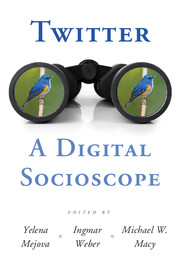1 - Analyzing Twitter Data
Published online by Cambridge University Press: 05 May 2015
Summary
Twitter is a social network with over 250 million active users who collectively generate more than 500 million tweets each day. In social sciences research, Twitter has earned the focus of extensive research largely due to its openness in sharing its public data. Twitter exposes an extensive application programming interfaces (APIs) that can be used to collect a wealth of social data. In this chapter, we introduce these APIs and discuss how they can be used to conduct social sciences research. We also outline some issues that arise when using these APIs, and some strategies for collecting datasets that can give insight into a particular event.
Introduction
Twitter is a rich data source that provides several forms of information generated through the interaction of its users. These data can be harnessed to accomplish a variety of personalization and prediction tasks. Recently, Twitter data have been used to predict things as diverse as election results (Tumasjan et al., 2010; c.f. Chapter 2) or the location of earthquakes (Sakaki et al., 2010; c.f. Chapter 6). Twitter currently has over 250 million active users who collectively generate more than 500 million tweets each day. This creates a unique opportunity to conduct large-scale studies on user behavior. An important step before conducting such studies is the identification and collection of data relevant to the problem.
Twitter is an online social networking platform where the registered users can create connections and share messages with other users. Messaging on Twitter is unique, as messages are required to be at most 140 characters long, and these messages are normally broadcast to all the users on Twitter. Thus, the platform provides an avenue to share content with a large and diverse population with few resources. These interactions generate different kinds of information. Information is made accessible to the public via APIs or interfaces where requests for data can be submitted. In this chapter, we introduce different forms of Twitter data and illustrate the capabilities and restrictions imposed by the API on Twitter data analysis.
- Type
- Chapter
- Information
- Twitter: A Digital Socioscope , pp. 21 - 51Publisher: Cambridge University PressPrint publication year: 2015
References
- 2
- Cited by

